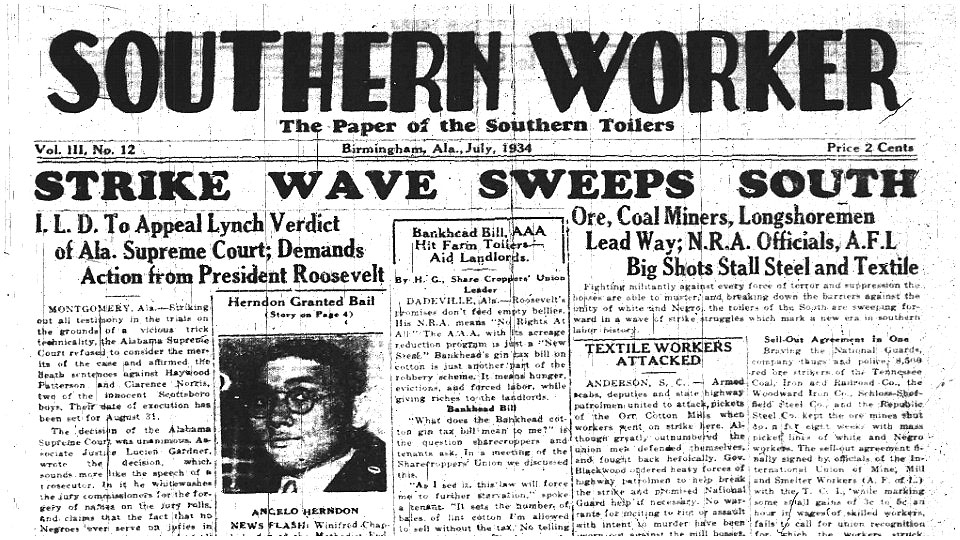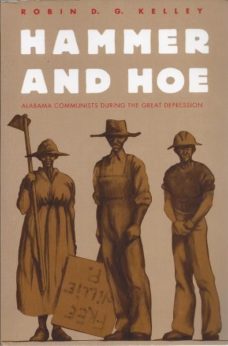
Now that open racism is emanating from the highest levels of the U.S. government and white supremacist terrorism is stalking the land, it’s worthwhile to look back at times of our history when our people faced similar challenges. The book Hammer and Hoe: Alabama Communists During the Great Depression, by Robin D.G. Kelley, a professor of history at University of California Los Angeles, provides a view of one such period that is rich with lessons for today’s struggles. The book was originally published in 1990, but updated and re-published in 2015.
 Alabama in the 1930s makes today’s Trump America look positively idyllic. Jim Crow terror against African Americans and trade unionists ruled, perpetrated not only by organizations like the Ku Klux Klan, which at that time was a “respectable” outfit claiming millions of members but also by law enforcement. Kelley tells of a sheriff who openly boasted of the number of union activists he had murdered. African Americans who tried to defend themselves against racist violence wound up in prison or the electric chair, while their attackers went free, and anyone who dared advocate racial equality or worked to organize a union put his life in peril.
Alabama in the 1930s makes today’s Trump America look positively idyllic. Jim Crow terror against African Americans and trade unionists ruled, perpetrated not only by organizations like the Ku Klux Klan, which at that time was a “respectable” outfit claiming millions of members but also by law enforcement. Kelley tells of a sheriff who openly boasted of the number of union activists he had murdered. African Americans who tried to defend themselves against racist violence wound up in prison or the electric chair, while their attackers went free, and anyone who dared advocate racial equality or worked to organize a union put his life in peril.
That would hardly seem to be an environment in which progressive movements of any sort, let alone the Communist Party, could flourish. But as Kelley tells the story, the party, though for the most part forced to work underground, attracted many working-class and poor members, mostly African-American, and had considerable impact, organizing unions and helping make space for other progressive organizations to function. In particular, it was a major force in building the labor movement in the state (as elsewhere in the South and throughout the country).
The Alabama Communist Party succeeded in some of its key aims because it saw from the start the inextricable link between racism and anti-working class attitudes and actions. In the atmosphere of the South in the 1930s, it could hardly have done otherwise; as pointed out above, open terror reigned equally against African-Americans and unionists—who were often, of course, the same people, as some (unfortunately not all) unions were virtually the only integrated institutions in the region at that time.

2019 marks a century since the founding of the Communist Party USA. To commemorate the anniversary of the oldest socialist organization in the United States, People’s World has launched the article series: 100 Years of the Communist Party USA. Read the other articles published in the series and check out the guidelines about how to submit your own contribution.
Indeed, the Alabama Communists saw this link more clearly than some in the party’s national leadership. A Communist leader named John Owens openly opposed recruiting Southern Blacks into the Party because “the vast majority of southern Negroes are not revolutionary, not even radical. Given a society of peace, prosperity, and security, they are content to drift through life.” This obviously racist attitude testifies to the immaturity of some segments of the party in that era.
Fortunately, the party as a whole quickly outgrew such thinking, in part because of the determined struggle of African-American (and working-class white) Communists in the South, for whom the struggles against racism and for the right to organize were unmistakably linked. This lesson, of course, is very much applicable today, not only to Communists but to progressives of any stripe, as the virulent racism and anti-worker and anti-union policies of the Trump regime daily demonstrate.
The Alabama party was largely African-American, though some working-class whites also played important roles. Most white workers, however, were swayed by the open racist ideology then dominant in the South (and in much of the North) to the point where they could not see their common interests with their African-American class sisters and brothers—a demonstration of the role of racism in dulling class consciousness, a phenomenon already noted by Karl Marx decades earlier.
In the face of, to put it mildly, the inhospitable climate for progressive action that 1930s Alabama presented, what can account for the quiet success of the Communist Party? One factor was the Communists’ ability to join in key struggles that won them respect and allegiance, especially among African-Americans. For example, the party’s vigorous defense—not just in Alabama but nationally and even internationally—of the Scottsboro Nine galvanized Birmingham’s Black community and put the party on the political map. The Scottsboro Nine were young African-Americans convicted and sentenced to death on trumped-up rape charges. The campaign for unemployment insurance likewise cemented support for the party among African-Americans and even some poor whites.
Another factor that increased the party’s appeal was the active role of women—an issue on which, again, the Alabama party was ahead of many white Communists, who, despite impressive rhetoric about women’s equality, still often relegated women to secretarial and other menial roles. Kelley points out that “the tradition of autonomous black women’s religious and social organizations served as conduits for the broader movement and were prototypes for the women’s auxiliaries” of unions.
This is but one example of one other factor in the party’s effectiveness that Kelley brings out clearly: its rootedness in the culture and history of both African-Americans and poor whites—including radical currents reaching deep into the past that historians have often neglected.
“Upon [Communism’s] Euro-American left-wing frame,” he writes, “was placed…a heritage of agrarian radicalism, limited interracial labor militancy, evasive and cunning forms of resistance, prophetic Christian ideology, ‘race’ consciousness, and interracial class conflict.”
To these traditions of resistance, communism added an understanding of the class roots of poverty and racism and an approach to struggling effectively against both—what later party leader Gus Hall termed the “Communist plus.”
Again, there are lessons here for today. The Marxist analysis of society and Marxist guidance on working-class and other struggles are a crucial contribution of the Communist Party to the broader progressive movement.
Of particular interest in Kelley’s account is also the interplay of religion, as a central part of regional culture, and communism. Most members and leaders of the Alabama party were active in their churches and often in such institutions as Gospel quartets as well. Kelley quotes a story by famed Communist journalist Joseph North of a “sharecropper comrade” who “had read the Worker [the Communist newspaper] for years; solid and reliable; he was respected by his folk here, who regarded him as a ‘man with answers.’ The sharecropper was an elder in the Zion [A.] M.E. Church, who ‘trusts God but keeps his powder dry’; reads his Bible every night, can quote from the Book of Daniel and the Book of Job . . . and he’s been studying the Stalin book on the national question.”
Communists often served as deacons or elders in their churches. Alabama Communists were as rooted in their community and culture—including its religion—as in Marxism. Today also, the party has members active in their religious communities and its Religion Commission is working to build ties with religious social justice advocates. There is a rich history of such ties that can inform present-day efforts.
Hammer and Hoe was not only an important contribution to working-class history when it first appeared almost 30 years ago; it also provided (and still provides) much inspiration as the Communist Party USA strives to become a mass party. The book and the time it covered also have valuable lessons for all progressives. Activists today need to understand that they are building on a long and powerful heritage of working-class and anti-racist organization and struggle in this country.










